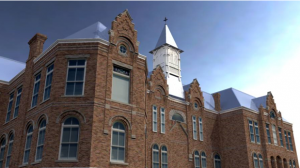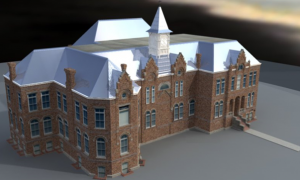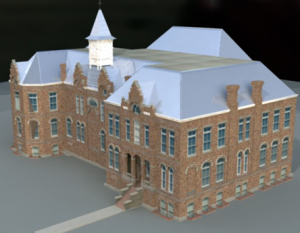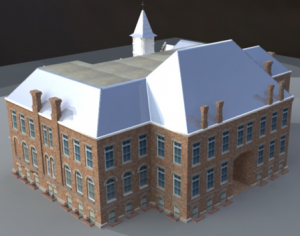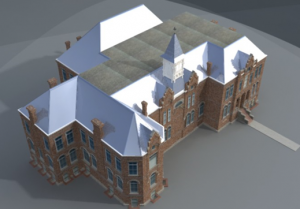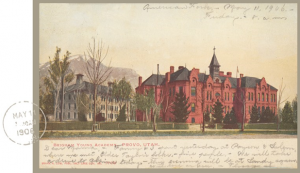Davido Hyer and Professor Brad Westwood, HBLL L. Tom Perry Special Collections
BYU has a rich architectural history that is in danger of being forgotten with the changing times. I started this project with the intent to help preserve some of this deep history in a digital format that the public would be able to easily understand. Most students and faculty probably don’t know any of the background surrounding the building of the BYU campus. I will present a short history of the Academy building followed by a brief outline of the process I went through in creating this piece.
The Brigham Young Academy was established October 16, 1875 with the intent to fuse scholarly learning with scriptural teachings. Karl G. Maeser, the first principal of the Academy, commented that the strength of this educational institution did not lay in her financial condition or in the quality of her teachers. The strength of this campus would be in her graduates ability to help redeem the world from sin, ignorance, and degradation. He wrote, “In order to do this, Zion will have to take the lead in everything and consequently also in education.” President Brigham Young commented that neither the alphabet nor the multiplication table should be taught without the Spirit of God. Hence, you can see that from the earliest days of this institution, it’s goals were that “All students at BYU should be taught the truths of the gospel of Jesus Christ. Any education is inadequate which does not emphasize that His is the only name given under heaven whereby mankind can be saved. Certainly all relationships within the BYU community should reflect devout love of God and a loving, genuine concern for the welfare of our neighbor.”
The early campus had much public opposition. Of this opposition, Karl G. Maeser wrote, “To make matters still worse, there were many even among the influential men in the community who not only had no confidence in the stability of the new venture, but openly opposed it by using their influence against it. Yet there were not wanting some signs prophetic of a more prosperous future, in the growing enthusiasm of the students, in the spreading influence outside the schoolroom, in the unqualified support of President Abraham O. Smoot, and in the approval of the Presidency of the Church. This was the condition of affairs when in August of the same year the first term of the first academic year was commenced.” 1 These adversities it turns out were blessings in disguise to the establishment of this great institution. Opposition ensured that both the teachers who taught there and the students who attended were dedicated to the institutions sacred cause. Since it had to rely on the liberality of her patrons, the Academy drew the interest of people in its mission.
The school had financial problems and the original building was destroyed in 1884 by fire. The school moved into the Academy Building in 1891 through the help and sacrifice of Abraham O. Smoot. In 1909, work was begun on Temple Hill to start the creation of the campus that we now enjoy. The name of the building was changed several times over the years until it was closed in 1968 with the final name of the “Brigham Young High School”. In 1975, BYU sold the Academy Building. For years this beautiful building sat abandoned and fell into disrepair. In March 1994, Provo City bought Academy Square. Provo City had planned to demolish the building and build condominiums. Through the efforts of over 2000 people, over $5.4 million dollars were donated to restore the historic Academy Building and convert it into a public library.
As you can see, the Academy Building has a rich history that has affected the lives of thousands. In my research to recreate the academy building, I found that the easiest way to accurately recreate this magnificent building was to acquire copies of the original blueprints. From there I created accurately sized walls onto which I could add other important features. To recreate the brickwork, windows and doors, I went to Academy Building and took hundreds of photos of the various features and took measurements as well. I received permission from the library administrator and went up to the roof to take pictures and measurements of features on the roof as well as to more closely examine the roofs texture. Once I had acquired all of this data, I used this information as reference to recreate the same features on the 3D walls I had created from the blueprints. As you’ll notice, the roof is a bluish-gray color in my renderings. This is due to the fact that Brad Westwood, from his research, strongly believes that the original roof was this color, and not the red color it currently is. I found proof of this in a postcard picture of the Academy Building from it’s early days, (see the attached picture at the end of this document). Sadly, I didn’t have enough time to finish the entire building. There were a few windows that got left out, and the front and back entrances need to be finished. Other than that, things went rather well. I plan on finishing up these features as I have time.
This has been a great learning experience for me. It has opened my eyes to the great history that BYU has built over the years and the great sacrifices and devotion that have been poured into it. I have come to more fully appreciate the unique architectural style of the Academy Building as well as the mission of BYU.
